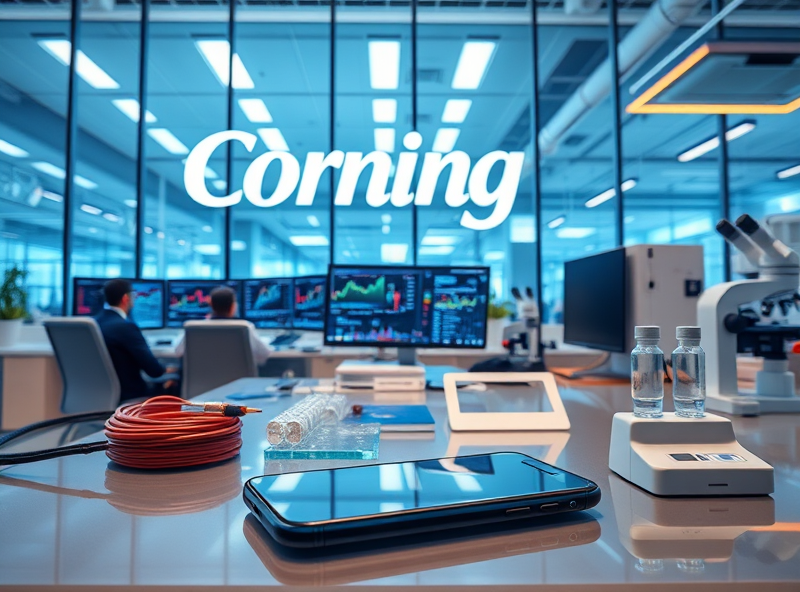
Corning Stock Analysis: Will This Materials Innovator Shine in Your Portfolio?

When it comes to investing in innovative companies with a strong legacy and future potential, Corning Incorporated (NYSE: GLW) often finds its way into the conversation. With over 170 years of history, Corning has transformed from a traditional glass manufacturer into a high-tech materials science leader. But is Corning stock a smart addition to your portfolio in 2024? Let’s dive into a comprehensive analysis to help you make an informed decision.
Understanding Corning’s Business Model
Corning operates across five key segments: Display Technologies, Optical Communications, Environmental Technologies, Specialty Materials, and Life Sciences. Each of these segments plays a critical role in modern technology infrastructure.
– Display Technologies: Corning is a global leader in LCD glass substrates, used in TVs, monitors, and mobile devices.
– Optical Communications: Corning supplies fiber optic cables and connectivity solutions, benefiting from the ongoing 5G rollout and broadband expansion in the U.S.
– Environmental Technologies: This segment produces ceramic substrates and filters for emissions control in vehicles.
– Specialty Materials: Home to the famous Gorilla Glass, used in smartphones and tablets.
– Life Sciences: Corning provides labware and equipment for biotech and pharmaceutical companies.
This diversified portfolio helps Corning weather industry-specific downturns and capitalize on long-term trends in technology and sustainability.
Recent Financial Performance
As of Q1 2024, Corning reported revenues of $3.2 billion, showing modest year-over-year growth. While margins have been under pressure due to inflation and supply chain issues, the company has managed to maintain profitability. The adjusted EPS stood at $0.38, slightly above analyst expectations.
Corning’s management reaffirmed its full-year guidance, citing strong demand in Optical Communications and Specialty Materials. The company also continues to return value to shareholders through dividends and share repurchases, maintaining a dividend yield of around 3.4%.
Growth Catalysts
Several macro and microeconomic factors are working in Corning’s favor:
1. 5G and Broadband Expansion: The U.S. government’s infrastructure bill includes funding for broadband expansion, directly benefiting Corning’s Optical Communications segment.
2. EV and Clean Energy Trends: Corning’s Environmental Technologies are aligned with the shift toward cleaner transportation.
3. Smartphone and Tablet Demand: As mobile device manufacturers continue to innovate, demand for durable and lightweight materials like Gorilla Glass remains strong.
4. Biotech Boom: The Life Sciences segment is poised to grow as biotech research and development accelerates post-pandemic.
Risks to Consider
No investment is without risk. Here are some factors that could impact Corning’s performance:
– Supply Chain Disruptions: Although improving, global supply chains remain fragile.
– Competitive Pressure: Emerging materials companies and tech giants may develop alternatives to Corning’s products.
– Cyclical Demand: Segments like Display Technologies are sensitive to consumer electronics cycles.
– Currency Fluctuations: As a global company, Corning is exposed to foreign exchange risks.
Valuation and Analyst Outlook
As of May 2024, Corning trades at a forward P/E ratio of around 15x, which is relatively attractive compared to peers in the materials and tech sectors. Analysts have a consensus “Buy” rating, with price targets ranging from $36 to $42, suggesting a potential upside of 10–20% from current levels.
Should You Invest in Corning?
Corning offers a compelling mix of innovation, diversification, and dividend income. It may not be a high-growth tech stock, but it provides stability and exposure to several high-growth industries. For long-term investors seeking a materials science company with a strong moat and consistent performance, Corning could be a valuable addition to a balanced portfolio.
Disclaimer
This article is for informational purposes only and does not constitute financial advice, investment recommendations, or an offer to buy or sell any securities. Always conduct your own research or consult with a licensed financial advisor before making investment decisions. The author and publisher are not responsible for any financial losses incurred based on the information provided herein.
